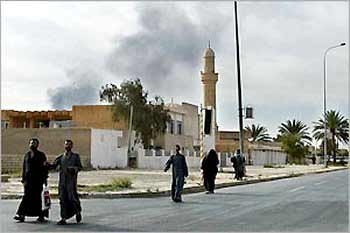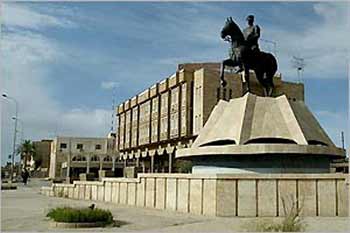U.S. forces suspected about 2,500 die-hards of the Republican Guard and the paramilitary Fedayeen - and possibly officials from the Iraqi president's regime - were holed up in the city. In the north of the city Brig. Gen. John Kelly of the 1st Marine Division, commander of the Tikrit operation, said the stronghold was "...the heartland of the beast. ... The beast is Saddam Hussein. If you were a committed regime murder guy, I guess you'd come here." Kelly described what he called a pattern of behavior in cities that the coalition forces have taken over. "It was a ghost town when we first arrived," he said. "Then they (residents) start sticking their noses out and approaching us and start pointing out where Baathists are, and the Fedayeen and the caches of weapons." Some of the Marines in the street were
wearing pink blossoms on their uniforms from flowers given them by residents
of the neighborhood.
"As soon as we got here we had some engagements against some small pockets of resistance," he said. The morning combat came after a night of heavy bombing and after Marines made several forays in and out of the city Sunday, drawing occasional small-arms fire and rocket-propelled grenades. The assaults Sunday did not encounter the intense battle that once seemed likely. Defense Secretary Donald Rumsfeld said there was "no organized resistance" in Tikrit. "A lot of people have disappeared, including the leadership of the Baath party," Rumsfeld told MSNBC on Sunday. "There are people (in Tikrit) who do not have a lot of admiration for the Baathist regime ... who are helping" the Americans, he told NBC. The Americans destroyed a tank column moving outside the town Sunday and killed a platoon of 15 to 20 Iraqis who attacked the Marines' armored vehicles, the operation's commander, Brig. Gen. John Kelly, told the New York Times correspondent. Cobra helicopters also destroyed six fully loaded but unmanned anti-aircraft guns on the city outskirts before U.S. troops in light armored vehicles began moving into Tikrit on Monday morning, the Marines said. As they moved from Baghdad to Tikrit, the Marines rescued seven American prisoners of war held by the Iraqis for three weeks. The Arab TV network Al-Jazeera reported that local tribal groups in Tikrit offered to negotiate peace with U.S. forces and hand over some Baath Party leaders in town. The tribal groups said the regular army, Republican Guards and Fedayeen Saddam reportedly left the city five days ago. Tikrit, 90 miles north of Baghdad, is the last major city with substantial resistance by Iraqi forces. Saddam was born in the area, and many members of his inner circle come from the region. After the fall of Baghdad last week, U.S. commanders cautioned that Saddam's regime might try to hold on ferociously to Tikrit. But they played down that possibility in recent days because of desertions and damage from sustained airstrikes. Before the Marines' arrival in Tikrit, live footage aired by CNN showed no signs of active Iraqi defenses, suggesting that days of bombing had achieved their intended effect. On the road connecting Tikrit and Tuz Khurmatu in the east, there were many abandoned checkpoints, bunkers, foxholes and an artillery position. Unlike in other major Iraqi cities, however, the many portraits, banners and statues of Saddam remained undamaged. There were no reports of looting. "We like Saddam Hussein and he has educated our people and we will support him to the end," said Abdul al-Jabouri, part of a large group of men gathered at a gas station. However, another man approached and said, "Long live the United States."
|

